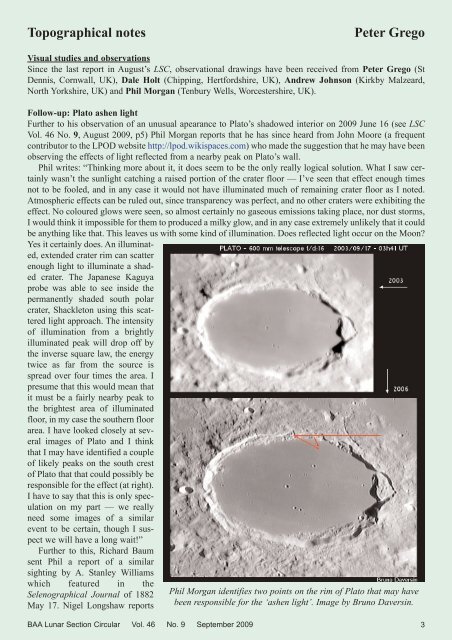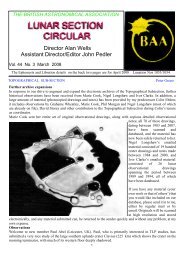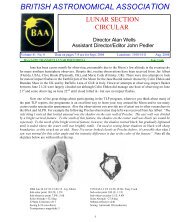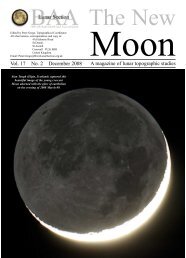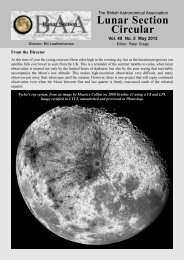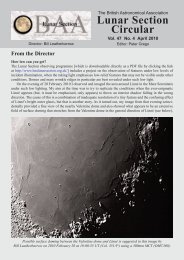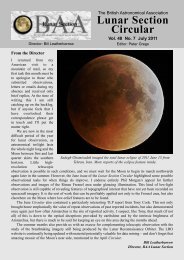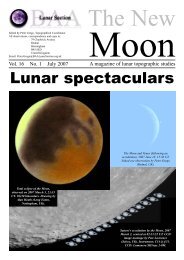Vol 46, No 9, September 2009 - Lunar Section
Vol 46, No 9, September 2009 - Lunar Section
Vol 46, No 9, September 2009 - Lunar Section
Create successful ePaper yourself
Turn your PDF publications into a flip-book with our unique Google optimized e-Paper software.
Topographical notesPeter GregoVisual studies and observationsSince the last report in August’s LSC, observational drawings have been received from Peter Grego (StDennis, Cornwall, UK), Dale Holt (Chipping, Hertfordshire, UK), Andrew Johnson (Kirkby Malzeard,<strong>No</strong>rth Yorkshire, UK) and Phil Morgan (Tenbury Wells, Worcestershire, UK).Follow-up: Plato ashen lightFurther to his observation of an unusual apearance to Plato’s shadowed interior on <strong>2009</strong> June 16 (see LSC<strong>Vol</strong>. <strong>46</strong> <strong>No</strong>. 9, August <strong>2009</strong>, p5) Phil Morgan reports that he has since heard from John Moore (a frequentcontributor to the LPOD website http://lpod.wikispaces.com) who made the suggestion that he may have beenobserving the effects of light reflected from a nearby peak on Plato’s wall.Phil writes: “Thinking more about it, it does seem to be the only really logical solution. What I saw certainlywasn’t the sunlight catching a raised portion of the crater floor — I’ve seen that effect enough timesnot to be fooled, and in any case it would not have illuminated much of remaining crater floor as I noted.Atmospheric effects can be ruled out, since transparency was perfect, and no other craters were exhibiting theeffect. <strong>No</strong> coloured glows were seen, so almost certainly no gaseous emissions taking place, nor dust storms,I would think it impossible for them to produced a milky glow, and in any case extremely unlikely that it couldbe anything like that. This leaves us with some kind of illumination. Does reflected light occur on the Moon?Yes it certainly does. An illuminated,extended crater rim can scatterenough light to illuminate a shadedcrater. The Japanese Kaguyaprobe was able to see inside thepermanently shaded south polarcrater, Shackleton using this scatteredlight approach. The intensityof illumination from a brightlyilluminated peak will drop off bythe inverse square law, the energytwice as far from the source isspread over four times the area. Ipresume that this would mean thatit must be a fairly nearby peak tothe brightest area of illuminatedfloor, in my case the southern floorarea. I have looked closely at severalimages of Plato and I thinkthat I may have identified a coupleof likely peaks on the south crestof Plato that that could possibly beresponsible for the effect (at right).I have to say that this is only speculationon my part — we reallyneed some images of a similarevent to be certain, though I suspectwe will have a long wait!”Further to this, Richard Baumsent Phil a report of a similarsighting by A. Stanley Williamswhich featured in theSelenographical Journal of 1882May 17. Nigel Longshaw reportsPhil Morgan identifies two points on the rim of Plato that may havebeen responsible for the ‘ashen light’. Image by Bruno Daversin.BAA <strong>Lunar</strong> <strong>Section</strong> Circular <strong>Vol</strong>. <strong>46</strong> <strong>No</strong>. 9 <strong>September</strong> <strong>2009</strong> 3


